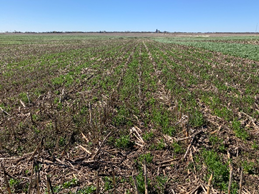On the morning of April 20, Illinois State University held its first Cover Crop Field Day at the University Farm at Lexington. The event was designed to provide farmers, students, industry professionals, and the public an opportunity to tour the farm, to learn about cover crops, and to hear about waste and water management at the farm. Illinois State’s Agriculture Department highlighted its many collaborative efforts with faculty, students, and researchers in Illinois State’s School of Biological Sciences, the startup company CoverCress Inc. in St. Louis, and Western Illinois University’s School of Agriculture.
The day began with signing in at 8:30 am followed by tours and 10 sessions that counted for CEU (continuing education unit) credit. Researchers, faculty, and collaborators presented and discussed topics including developing pennycress (a naturalized weed) into the oilseed cash cover crop CoverCress, Illinois State’s saturated buffer system and its benefits in managing field water runoff, uses of cereal rye as a cover crop and animal feed, the farm’s compost facility and use of the compost for crop production.
Mark Messmer from CoverCress, Inc. spoke about pennycress natural variation and breeding efforts that have allowed it to be transformed into a cash cover crop named CoverCress—a crop that provides the ecological benefits of a cover crop while producing harvestable and marketable oilseeds in early spring. This new crop fits into the popular corn-soybean rotation, planted in standing corn or upon corn harvest, and then itself harvested with a standard combine in May in time to plant soybeans.
Nicholas Heller, an assistant professor of crop science in Illinois State’s Department of Agriculture, highlighted his research plots studying planting methods and how to best manage corn residue in attempting to get a sufficient CoverCress stand established in the fall.
Sarah Kilver, a senior in the Department of Agriculture at Illinois State working on cover crops with Heller, discussed and showed plots of annual rye, oats, and tillage radish, as well as plots of cereal rye that are being utilized at the University Farm as a cover before harvesting for animal feed. “This field day really was one of the best parts of my final semester at ISU,” Kliver said “I know it will help me succeed in the agronomy industry postgraduation! I am excited to see how this event may grow in the future, and hopefully future students will take the opportunity of working beside Dr. Heller.”
Bill Perry, professor of water ecology in Illinois State’s School of Biological Sciences, talked about work done with The Nature Conservancy in examining watershed management practices and the beneficial effects of cover crops.
Perry, along with Rob Rhykerd, chair of Illinois State’s Department of Agriculture, discussed agricultural streams’ ecology, biogeochemistry, and best management practices of farm water runoff. On display was the recently installed saturated buffer system controlling water flow into Turkey Creek, which runs through the University Farm. Michael Ruffatti, a research technician in the Department of Agriculture, detailed cover crops’ nutrient capturing abilities and availability of the nutrients once the cover crops are terminated.
John Sedbrook, a professor in ISU’s School of Biological Sciences, and Winthrop Phippen, a professor from Western Illinois University, spoke on the advances being made in identifying pennycress germplasm best suited for production agriculture and the use of cutting-edge genetic technologies to rapidly improve pennycress seed quality and growth.
Presentations were finished off by Ken Smiciklas, professor of agronomy at Illinois State, who talked about how farm and municipal waste was being efficiently converted into compost on the University Farm. Smiciklas highlighted how the compost, which is available for purchase, is an effective fertilizer and soil amendment.
The event closed with lunch from Kelly’s on 66, provided by Heller. The lunch hour allowed time for networking and planning for next year’s cover crop plantings. Rhykerd, Sedbrook, and Heller agreed that the field day was a successful event and are enthusiastic about doing it again next year. Moving forward also means getting closer to what they hope will be commercial launch of CoverCress in 2021.
“It is exciting to see how universities, industry, and farmers are all working together to develop pennycress into this new cash cover crop, CoverCress,” Sedbrook said.
Approximately 40 people were in attendance, which included speakers, members of our faculty, alumni, current students, prospective students and family, industry professionals, and interested community members. “Great attendance for our first year,” Heller said.



